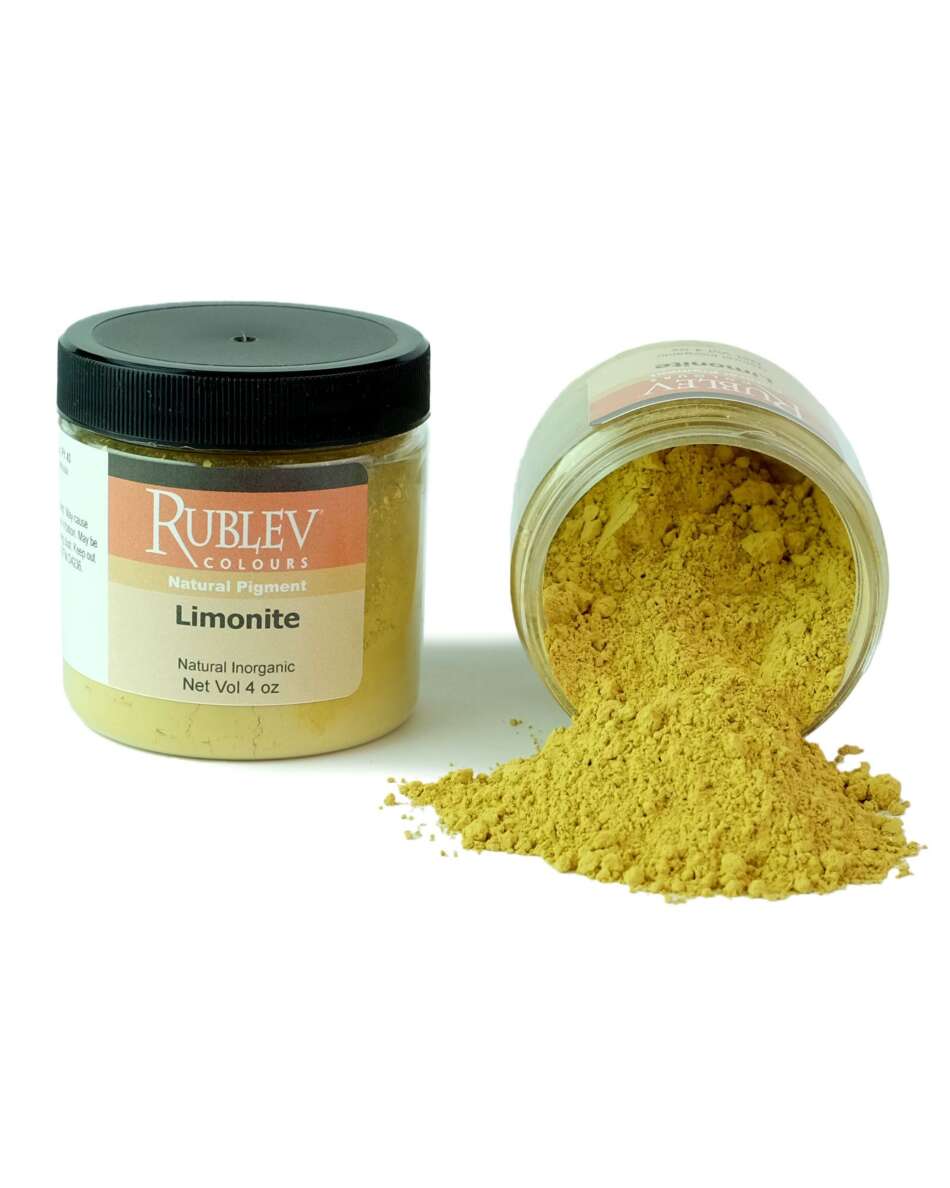Limonite Pigment
Limonite is a yellow earth pigment known since Antiquity. Limonite is derived from a mixture of natural minerals obtained in Cyprus. Learn more.
Rublev Colours Limonite is yellow earth pigment from a natural mixture of minerals obtained in Cyprus. Limonite is not a true mineral but a mixture of similar hydrated iron oxide minerals. Limonite is mostly made up of the mineral goethite.
| Pigment Names | |
| Common Names: | English: limonite German: Limonit Italian: limonita Russian: лимониг Spanish: limonita |
| Synonyms: | bog ore, brown hematite, brown ocher, ferrohydrite, ferrum limosum, gel-Goethite, hydroferrite, hydrosiderite, hyposiderite, marsh ore, meadow ore, Morasterz, Ortstein, Pecheisenstein, Perlimonite, Raseneisenstein, Seeerz, Sumpferz, yellow ocher |
Origin and History
Known since antiquity, limonite is the natural mineral composing the pigment known as ocher (okhra in Greek). Ocher has been used as a pigment since prehistoric times and is perhaps the most widely used pigment for artists' paints. Limonite is named from the Greek word for "meadow," an allusion to its occurrence as a "bog ore" in meadows and marshes.
Source
Rublev Colours Limonite is yellow earth pigment from a natural mixture of minerals obtained in Cyprus. Limonite is a natural earth containing clay tinted by hydrated iron oxide and traces of calcium sulfate (gypsum) or calcium carbonate (chalk). Limonite is a general term used to describe all forms of hydrated iron oxide minerals (FeOOH) that occur as natural clay or earth. Limonite includes the minerals goethite, akaganeite and lepidocrocite. Limonite forms mostly in or near oxidized iron and other metal ore deposits, and as sedimentary beds. Depending upon the content of hydrated iron oxide, the color of limonite varies from yellow to brownish-black.
Permanence and Compatibility
Limonite is among the most permanent colors among the artists' palette. It is compatible with all other pigments, and can be used with good results in all mediums.
Oil Absorption and Grinding
Limonite absorbs a moderate amount of oil. The oil absorption ratio is 35 parts by weight of linseed oil to 100 parts by weight of pigment. If the measurement were grams, limonite would require 35 grams of linseed oil to grind 100 grams of pigment to form a stiff paste.
Toxicity
Limonite is not considered toxic, but care should be used in handling the dry powder pigment to avoid inhaling the dust.

Pigment: Limonite
| Pigment Information | |
| Color: | Yellow |
| Colour Index: | Pigment Yellow 43 (77492) |
| Chemical Name: | Iron Oxide Hydroxide |
| Chemical Formula: | α-FeOOH |
| ASTM Lightfastness Rating | |
| Acrylic: | I |
| Oil: | I |
| Watercolor: | I |
| Properties | |
| Density: | 2.9–4.3 |
| Hardness: | 4.0–5.5 |
| Refractive Index: | 2.260–2.398 |
| SKU | 431-10 |
|---|---|
| Brand | Rublev Colours |
| Vendor | Natural Pigments |
| Processing Time | Usually ships the next business day. |
| Color | Yellow |
| Pigment Type | Inorganic, Earth, Natural |
Health & Safety: There are no acute or known chronic health hazards with the anticipated use of this product (most chemicals are not thoroughly tested for chronic toxicity). Protect yourself against potentially unknown chronic hazards of this and other chemical products by avoiding ingestion, excessive skin contact, and inhaling spraying mists, sanding dust, and concentrated vapors from heating. Contact us for further information or consult the SDS for more information. Conforms to ASTM D-4236.



